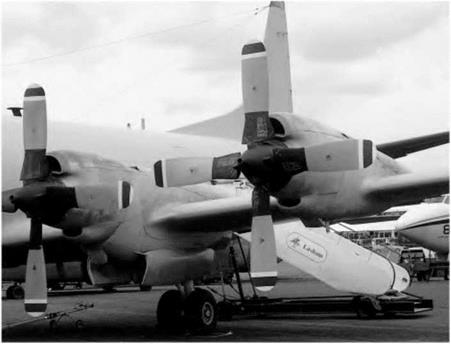The ramjet and scramjet
The ramjet engine will be mentioned here, because, although hardly ever used for aircraft, it is important for missiles and potentially important for the early stages of spacecraft flight. In principle, the ramjet is extremely simple, and, as
|
|
Fig 4B Turboprop propulsion
The Lockheed Orion with four turboprops. Note the huge wide-chord ‘paddle-blade’ propellers.
shown in Fig. 4.2, consists of nothing more than a duct or tube of a special shape which faces the airflow in a moving aircraft. It relies on the forward speed to collect and compress the air, the so-called ram effect described in the preceding section. The air thus compressed flows past, a source of heat, such as a jet of burning fuel, as in a jet engine. From this, the air gains energy, flowing out faster than it entered. As with the jet engine, the reaction to this increase in air flow speed and momentum is a thrust force, which pushes the engine forward. This simple engine has no moving parts and there is almost nothing to go wrong. The exhaust air jet does not need to drive a turbine, and can be used entirely for direct thrust production. It should be noted that the shape of the duct is important. You cannot make a ramjet by burning fuel in a simple constant-bore tube; all you would get from that would be drag and some hot air.
So if ramjets are so simple, why have they rarely been used on aircraft? The answer is that there is a major snag, and that is that they will only generate thrust efficiently at high speeds. In fact, they only start to become as efficient as a jet engine at several times the speed of sound. At zero forward speed they will not work at all, so any vehicle to be propelled by a ramjet must first be accelerated by some other type of engine or propulsion system. Ramjets have been used for missiles, as shown in Fig 4C. In this case, a simple rocket is used to propel the vehicle to a high speed, whereafter, the more efficient ramjet takes over. The rocket and ramjet combination thus gives a greater range than would be possible with the highly inefficient rocket engine alone. Ramjets have rarely been used on aircraft except for a few experimental types, but the SR71 ‘Blackbird’ spy-plane used a special engine which functioned as a turbojet engine at low speeds, and as a ramjet at high speeds.
 |
The scramjet (supersonic combusting ramjet) works on the same principle as the ramjet, but in this case, the air flow in the engine is everywhere supersonic. In very high speed hypersonic flight this is necessary, because the thermodynamic efficiency becomes too low if the air speed is reduced to less than the speed of sound anywhere in the engine. The problem is that in a supersonic flow, the flame produced by burning simple fuels simply blows out. One solution is to use two fuels that react violently as they are mixed. This may be acceptable for military aircraft and missiles, but fare-paying passengers
Fig 4.2 Principle of the ramjet
might not relish the idea of sitting in an aircraft containing highly reactive fuels that must never meet except in the combustion chamber!












